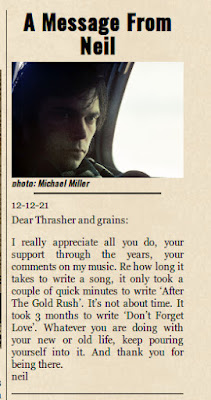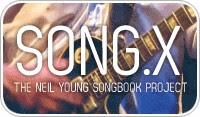UNCUT Magazine: Neil Young's "On The Beach" 50th Anniversary
UNCUT Magazine's February 2024 issue features Neil Young on the cover, celebrating the 50th anniversary of the album On The Beach.
There’s also a track-by-track, where Neil heads including Kurt Vile, J Mascis, Margo Price, Patterson Hood and Low’s Alan Sparhawk talk us through their favourite songs on the album.
The issue is in UK shops from Friday, January 5 and also available to buy direct from the Uncut store: https://shop.kelsey.co.uk/single-issue/uncut-magazine/334
Labels: neil young, on the beach, uncut magazine
































 Human Highway
Human Highway

















 Concert Review of the Moment
Concert Review of the Moment





 This Land is My Land
This Land is My Land

 FREEDOM In A New Year
FREEDOM In A New Year









 *Thanks Neil!*
*Thanks Neil!*




![[EFC Blue Ribbon - Free Speech Online]](http://www.thrasherswheat.org/gifs/free-speech.gif)











 The Unbearable Lightness of Being Neil Young
The Unbearable Lightness of Being Neil Young Pardon My Heart
Pardon My Heart



 "We're The Ones
"We're The Ones  Thanks for Supporting Thrasher's Wheat!
Thanks for Supporting Thrasher's Wheat!




 This blog
This blog 
 (... he didn't kill himself either...)
#AaronDidntKillHimself
(... he didn't kill himself either...)
#AaronDidntKillHimself









































































 Neil Young's Moon Songs
Neil Young's Moon Songs




 Civic Duty Is Not Terrorism
Civic Duty Is Not Terrorism Orwell (and Grandpa) Was Right
Orwell (and Grandpa) Was Right


 What's So Funny About
What's So Funny About 



7 Comments:
With Dume to be released on Vinyl, a probable 50th annniversary clear vinyl edition of "On the Beach", the by now almost dreaded NYA monstrous Vol. III, the "Early Daze" record also promised for 2024, I am reminded that I still have not seen any European vinyl for "Before + After" and that this will be a costly year for this Neil Young fan. A European tour (fall?) is not yet even part of the budget planning. Neither is the never unlikely possibility of a release of new material.
Has the Dume on vinyl announcement been taken off the NYA website? A couple of hours back it was still there, but it had no release date.
Most of my music listening attention lately had been on Peter Gabriel’s new album, I/O, which premiered in full the first week of December. PG’s approach and sound are almost radically different from NY: complex musical ideas, intricate, layered arrangements that average 6+ minutes per track. 12 tracks, about 70 minutes, and he issues the album in three distinct mixes simultaneously.
The product contains plenty of truth but more than three chords. Instead of NY’s strong folk influence, the key notes of the bouquet are prog, new wave, and hints of worldbeat. Highly global music, yet much more intimate and exposed than some of the electronic soundscapes would suggest at first flush. I think the commonality with NY lies in content, the sense of emotional honesty and conscience in the words. Where there’s a certain earnest simplicity about NY’s compositions, however, digesting a Peter Gabriel album is more like reading a long novel or exceptionally dense collection of poems; poets like Anne Sexually and Denise Levertov come to mind, Plath even.
The underlying point: where World Record and Before + After are short and (fairly) sweet, a Peter Gabriel recording typically consumes a lot of time and energy. This is true, too, from the artist’s perspective: where Neil seems to work quickly and intensively, Peter’s last original album prior to i/o was in 2002. One album in 20 years vs almost 1 album every year in a similar timeframe. Both artists, though, are deeply rewarding. A good return on investment. In a nutshell, NY creates great songs. PG builds soundscapes. For those who never quite made peace with new wave, PG’s sound may at first seem alienatingly inorganic or even artificial, but all the bells and whistles dance around a deep, palpable core of authenticity.
For eff sakes, I was referring to Anne Sexton, not “Anne sexually”!
This comment has been removed by the author.
Abner— yes: my nutshell summary is oversimplified and hasty. Expecting to Fly seems an outlier, but Neil has created some quite evocative soundscapes particularly in his longer experiments with the Horse. These are more a matter of plugging in and finding s groove with the band at a precise moment—each performance or take is potentially lightning in a bottle. That’s why all the live recordings are so exciting.
As juxtaposed with this kind of “use the first take” spontaneity, Peter Gabriel’s recordings are more like compositions in a formal sense, studio assemblages that sometimes verge on maximalism. The cohesive atmosphere of a band playing together all at once is perhaps sacrificed, or rather exchanged, to facilitate a global vision that allows many more musicians to contribute from various places at various times. Neil, too, is globally minded, but the aesthetic approach is much more unvarnished, not necessarily minimal but certainly valuing depth over breadth. With two quite different approaches to balancing the intimate with the universal, what remains common is the human scope of the songs.
I don't think you oversimplified, good writing
Post a Comment
<< Home